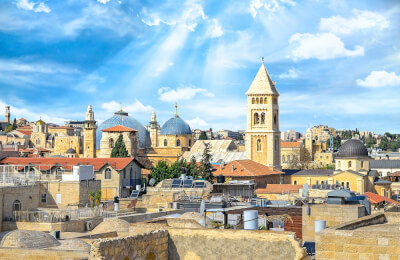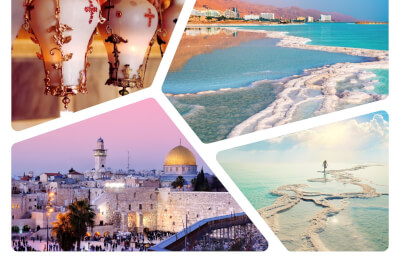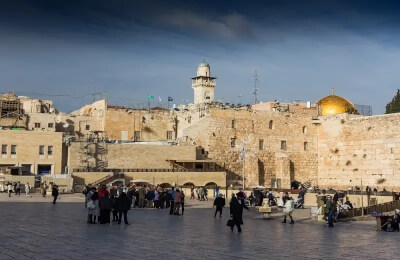
42. Walking Jerusalem Promotion
1. Christian Jerusalem Promotion

2. Jerusalem of three religions Promotion
5. Bethlehem and Christian Jerusalem Promotion
510. New Year in Jerusalem Promotion
554. Passover in Jerusalem Promotion
We also found excursions from other cities that are close to your departure city
Other excursions that also deserve your attention
The Wailing Wall: A Sacred and Historical Marvel in the Heart of Jerusalem
Introduction
Israel, a land steeped in history and spirituality, is a place of profound significance for people of various faiths. Amid its rich tapestry of cultural and historical landmarks, the Western Wall, also known as the Wailing Wall, stands as an emblem of spiritual devotion and historical remembrance. In this exploration of sightseeing in Israel, we will delve into the compelling allure of the Wailing Wall, uncover its unique history and religious importance, and reveal interesting facts that make it one of the most visited and revered sites in Jerusalem.
The Western Wall: A Sacred Site
The Western Wall, often referred to as the Wailing Wall, is an integral part of the larger complex known as the Western Wall Plaza. Located in the Old City of Jerusalem, it is one of the most significant religious and historical sites in the world, revered by Jews and admired by countless visitors from all walks of life.
1. Historical Significance
The Western Wall has a history that stretches back thousands of years. Originally, it was a retaining wall that supported the Second Temple, which was built by King Herod in the first century BCE. This Temple was one of the most important religious and cultural centers in the ancient world and played a central role in Jewish worship.
However, in 70 CE, the Second Temple was destroyed by the Romans during the Jewish-Roman War, leaving only the Western Wall standing. This event marked a turning point in Jewish history, leading to the Jewish diaspora. The Western Wall became a symbol of both loss and resilience, a place where Jews could gather to mourn the destruction of the Temple and pray for its rebuilding.
2. Religious Significance
For Jews worldwide, the Western Wall is the holiest site accessible for prayer. It is believed to be the closest physical location to the former Holy of Holies within the Temple, which was the innermost sanctum and the most sacred space in Judaism. Today, Jews from around the world come to the Western Wall to pray, often placing written prayers or wishes in the cracks between its ancient stones.
The act of praying at the Western Wall carries deep spiritual significance. Many visitors are moved to tears as they pour their hearts out in prayer, hence the nickname "Wailing Wall." The wall serves as a powerful reminder of Jewish history, faith, and the unbreakable connection to the land of Israel.
3. Architectural Marvel
Beyond its spiritual significance, the Western Wall is an architectural marvel. The massive stones that make up the wall are a testament to the engineering prowess of ancient civilizations. Some of the stones weigh several tons and are believed to have been transported from quarries over 20 miles away, showcasing the remarkable craftsmanship of the builders.
Interestingly, while the Western Wall is visible above ground, much of it extends underground. Over the years, archaeologists have uncovered tunnels and chambers beneath the Western Wall Plaza, shedding light on the site's history and the daily life of those who lived in Jerusalem during different periods.
4. Accessibility
The Western Wall is open to visitors of all backgrounds and faiths. There is no entrance fee, and visitors are provided with prayer books and yarmulkes (skullcaps) at the entrance if they wish to participate in the prayer services. The atmosphere is one of reverence and respect, making it a place where people from diverse backgrounds can come together to witness the power of faith and history.
Interesting Facts about the Western Wall
1. Gender-Segregated Prayer Areas: To accommodate the religious customs of Orthodox Judaism, the Western Wall Plaza has gender-segregated prayer areas. Men and women pray in separate sections, with the men's section being larger.
2. Note in the Wall: Visitors often write their prayers or wishes on pieces of paper and place them in the cracks between the stones of the Western Wall. These notes are collected periodically and buried on the Mount of Olives.
3. Notable Visitors: Over the years, the Western Wall has attracted numerous world leaders, celebrities, and dignitaries. Notable visitors have included former U.S. President Barack Obama, Pope John Paul II, and countless others.
4. Unique Archaeological Finds: The Western Wall Tunnel, an underground passage that runs along the Western Wall, offers a glimpse into the site's history. Visitors can see sections of the Western Wall that have been excavated and explore archaeological discoveries such as ritual baths and ancient Roman streets.
5. 24/7 Accessibility: The Western Wall is accessible at all hours, making it possible for visitors to pray or reflect at any time of day or night. This accessibility underscores its significance as a place of continuous devotion.
Conclusion
The Western Wall, or the Wailing Wall, is a place where history, spirituality, and architectural wonder converge. Its enduring significance in Judaism and its historical importance as the last remaining vestige of the Second Temple make it an essential stop for anyone visiting Israel. The site's accessibility, unique customs, and the power of witnessing people from diverse backgrounds come together in prayer create a profound and unforgettable experience. Whether you seek to connect with your faith, explore history, or simply marvel at the monumental stones that have stood the test of time, the Western Wall is a must-visit destination in the heart of Jerusalem. It is a place where the past and the present intersect, and where the human spirit is boundless in its capacity for devotion and remembrance.

























